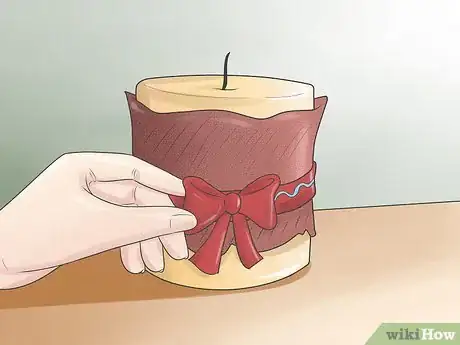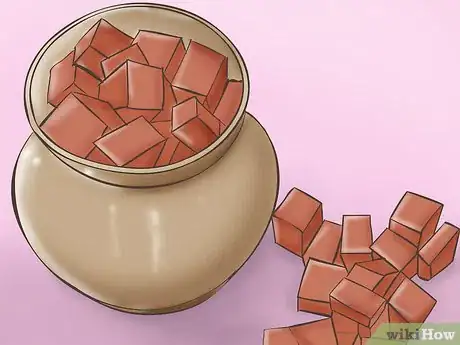This article was co-authored by wikiHow Staff. Our trained team of editors and researchers validate articles for accuracy and comprehensiveness. wikiHow's Content Management Team carefully monitors the work from our editorial staff to ensure that each article is backed by trusted research and meets our high quality standards.
There are 20 references cited in this article, which can be found at the bottom of the page.
wikiHow marks an article as reader-approved once it receives enough positive feedback. This article received 17 testimonials and 89% of readers who voted found it helpful, earning it our reader-approved status.
This article has been viewed 284,707 times.
Learn more...
Most people buy candles at one point or another, making them a great product for you to create and sell. To start a business, you first need to learn the appropriate skills for candle making. You also need to make your business legal and figure out where you are going to sell your candles to the public.
Steps
Making Candles
-
1Decide what type of candle you would like to make. When you're first starting out, it's best to stick with one or two products. In candles, making container candles is probably the simplest, but you can also make mold candles or taper candles.[1]
-
2Pick a wax to work with. Waxes come in several main groups. Which group you choose is mostly based on preference.
- One group is paraffin, which is a by-product of petroleum. You can find it in a variety of melting points, depending on what type of candles you are making. For instance, you need a higher melting point for tapers than you do for container candles.[2]
- Another type of wax is beeswax. Beeswax is a product that bees make, so it has a natural, light honey smell. Some people prefer this wax because it is all-natural, though others will mix beeswax with other waxes for their candles.[3]
- A third category of waxes is vegetable waxes, where soy is probably the most popular. One benefit of soy wax is it is pure white, and it also doesn't shrink up when you pour it, which means you don't have to pour wax more than once. Bayberry wax is also in this category.[4]
Advertisement -
3Learn the technique. One of the simplest ways to learn how to make candles is to take a class in your community. You may be able to find one with your local parks and recreation department or even at your local community college. However, you can also find a wide variety of tutorials online. In fact, you'll likely be able to find all you need to know online if that is your preference.[5]
- You can also check out books from your local library about candle-making.
-
4Practice the technique. Before you start selling, you need to take time to build up your skill. Try working a little bit each day on your business, starting with practicing a bit each day.
Dealing With the Legal Side
-
1Get a lawyer. When you're first starting your business, it can help to have a lawyer on your side. She can help you file the appropriate paperwork and ensure you have the correct licenses when you start your business.
-
2Pick a name. If you can't decide on a name at first, just pick anything. You are allowed to do business under a different name if you file it later as "Doing business under." In other words, if you don't like the name you choose, you can always change it later.[6]
-
3Choose the appropriate business structure. If you intend to keep your business on a small scale, you have the main options of sole proprietorship and limited liability company (LLC). A sole proprietorship is intended for a one-person company, but you are personally responsible for all the debts of the company. On the upside, it is easier to file for a sole proprietorship than an LLC. In an LLC, you are more separated from the business, meaning you are not personally responsible for the debt if the company goes under. In other words, you don't have to give up your house to pay the debts of the company, unless you do something illegal.[7]
-
4Apply for an employer identification number (EIN). This number identifies your business to the IRS. If you chose sole proprietorship, you don't absolutely need an EIN. However, it gives you a number to use for tax purposes that is not your Social Security Number, so it can be helpful.[10]
- The easiest way to apply for an EIN is online on the IRS website. The form only takes a few minutes to fill out, and you get your number quickly. The process is free.[11]
-
5Decide on the location of your business. Generally, if you own a small business without customers who visit your place of business, you can run it out of your home. However, you should always check with your city first to see what laws they have around home businesses. For instance, the city may not allow your business to run out of your garage.[12]
- Of course, you can also choose to start your business out of a storefront. In that case, you'll need to scout a location. In addition, buying or renting a space is a significant investment.[13]
-
6Ask about permits. Your city may require you to have certain permits to run your business. The easiest way to find out is simply to ask at your city clerk office, which should be able to tell you what you need.[14]
-
7Set up a business account. You can set up a business account with any bank, though it may make it easier to do it through a bank you already frequent. A business account helps you keep personal purchases separate from business purchases.[15]
-
8Keep track of your money. That is, make sure you are tracking what you spend and what you make. You don't necessarily need expensive software to keep track of it. You can do it in a spreadsheet, if you want.[16]
-
9Pay federal taxes quarterly. As a small business owner, you must pay your federal taxes in quarterly if you expect to pay in more than $1,000. It's similar to how your employer would withhold taxes for you, except now you must do it yourself.[17] You make payments through the Electronic Federal Tax Payment System.[18]
-
10Register for state taxes. You'll also need to pay state taxes, as well as the federal taxes. Generally, you pay company income taxes once a year, but you may need to pay in sales taxes more often, such as quarterly. Check with your state to see what it requires. You may even need to get a state identification number.
Selling Your Product
-
1Get a logo. You can design one yourself or hire a pro. A pro will have the experience to create a great logo you can use across many platforms. A logo is what represents your business to your customers, so it needs to be simple, interesting, and recognizable. Once you have a logo, you can use it to design labels for your candles and to create business cards.[21]
-
2Vend at craft fairs. Most cities, even small ones, have local craft shows where you can sell your wares. Consider a wide variety of options. For instance, even food and wine fairs often have crafting vendors. Of course, you'll also need to pay for booth space to participate.[22]
- Consider having complementary items for sale as well as the candles. For example, you could have homemade candle stands and bowls for floating candles for sale at the same time as your candles. A variety of items encourages shoppers to stop and browse.
-
3Sell in local stores. You have a couple of options when you offer crafts in local stores. Some stores will buy your product outright and resell it. Others will only take a commission when your product sells.[23] A third option is buying booth space in a craft store that sells local crafts.
- The easiest stores to get into are ones that offer booth space, as you pay for the space. However, it's not always easy to make your booth space back.
- When approaching stores with your wares, have pictures with you, as well as samples. Be professional by being polite and dressing up. In addition, always call first to see when an appropriate time to come in would be. Some stores prefer that you provide photos online.[24]
-
4Sell online. Craft websites are becoming more and more popular. Generally, you set up your own mini site through the larger site, creating a virtual store front. The website handles the transactions for you, and then you mail the product where it needs to go.[25]
- The best parts of using a craft website is you don't have to maintain a website, and you've got traffic built in. However, you don't have as much control over design or policies.[26]
- You can also build your own website, but that takes some technical know-how, especially if you want to add in a way to buy on the site.
-
5Market your product. One of the best ways to market your product is through social media. Basically, you set up business accounts on major social media websites. You can then friend people or use hashtags to attract customers.[27]
- It's important to engage with your customers and other people in the industry. If you just throw products at them, you're likely to turn customers off. However, if you build relationships, you'll be more likely to gain customers. That means offering value outside of your products (such as tutorials or funny content), talking with customers, and engaging with other people who are in the community.[28]
- If you want people to promote your content, you should be promoting others, as well. When someone shares your picture, try sharing something in return.[29]
- Share quality content. Quality content will get other people to share it as well. That means taking good pictures and being professional in everything you do.[30]
-
6Use keywords and hashtags to your advantage. One way to help people find your product is to use keywords and hashtags to your advantage. When you're selling on a crafting website, you need to find the right keywords to help your product stand out. That means picking keywords that are unique to your product but that are also trendy. Think about what you would use to search for your product.
- The same can be said of hashtags. On certain social media sites, hashtags are used to group pictures and content. By using the right hashtags, you'll find customers who will connect to your product. For instance, if you make 100 percent pure beeswax candles, you can use the hashtag #purebeeswaxcandles to help others find you.
Community Q&A
-
QuestionHow can I learn how to make candles?
 Community AnswerPlenty of websites provide tutorials on this. Here's an example: How to Make Homemade Candles.
Community AnswerPlenty of websites provide tutorials on this. Here's an example: How to Make Homemade Candles. -
QuestionWhere can I purchase an instrument for making candles?
 Community AnswerThere is not really an instrument, you just need the ingredients and tools, waxes, fragrances, containers, candle wicks, candle dye, measuring cups, spoons, a bowl, and a scale. All of these can be found on Amazon or at a store like Walmart.
Community AnswerThere is not really an instrument, you just need the ingredients and tools, waxes, fragrances, containers, candle wicks, candle dye, measuring cups, spoons, a bowl, and a scale. All of these can be found on Amazon or at a store like Walmart. -
QuestionHow can I purchase wax?
 Community AnswerYou can purchase wax at a local craft store like Michaels or online through Amazon.com or eBay. It is better to start with a smaller amount to see if you enjoy the process and also not make a huge initial investment. Then you can buy more supplies as you get comfortable and start experimenting with different waxes, fragrances, and containers.
Community AnswerYou can purchase wax at a local craft store like Michaels or online through Amazon.com or eBay. It is better to start with a smaller amount to see if you enjoy the process and also not make a huge initial investment. Then you can buy more supplies as you get comfortable and start experimenting with different waxes, fragrances, and containers.
References
- ↑ http://www.campbell-light.com/waxes.htm
- ↑ http://www.campbell-light.com/waxes.htm
- ↑ http://www.campbell-light.com/waxes.htm
- ↑ http://www.campbell-light.com/waxes.htm
- ↑ https://www.candlescience.com/learn-candle-making
- ↑ http://www.inc.com/jeff-haden/how-to-start-a-small-business-in-a-few-hours.html
- ↑ http://www.investopedia.com/university/small-business/protect.asp?header_alt=a
- ↑ http://www.investopedia.com/university/small-business/protect.asp?header_alt=a
- ↑ https://www.sba.gov/content/partnership
- ↑ http://www.inc.com/jeff-haden/how-to-start-a-small-business-in-a-few-hours.html
- ↑ https://www.irs.gov/businesses/small-businesses-self-employed/apply-for-an-employer-identification-number-ein-online
- ↑ http://www.investopedia.com/university/small-business/finding-location-getting-licenses.asp?header_alt=a
- ↑ http://www.investopedia.com/university/small-business/finding-location-getting-licenses.asp?header_alt=a
- ↑ http://www.inc.com/jeff-haden/how-to-start-a-small-business-in-a-few-hours.html
- ↑ http://www.inc.com/jeff-haden/how-to-start-a-small-business-in-a-few-hours.html
- ↑ http://www.inc.com/jeff-haden/how-to-start-a-small-business-in-a-few-hours.html
- ↑ http://www.investopedia.com/university/small-business/understanding-small-business-taxes.asp?header_alt=a
- ↑ https://www.eftps.gov/eftps/
- ↑ http://www.inc.com/jeff-haden/how-to-start-a-small-business-in-a-few-hours.html
- ↑ http://www.investopedia.com/university/small-business/understanding-small-business-taxes.asp?header_alt=a
- ↑ http://www.smallbusinesscomputing.com/tipsforsmallbusiness/does-your-business-logo-drive-away-customers.html
- ↑ http://www.businessknowhow.com/startup/craftbusiness.htm
- ↑ http://www.indiemade.com/resource/how-sell-your-crafts-stores
- ↑ http://www.indiemade.com/resource/how-sell-your-crafts-stores
- ↑ http://www.businessknowhow.com/startup/craftbusiness.htm
- ↑ http://www.businessknowhow.com/startup/craftbusiness.htm
- ↑ http://www.businessknowhow.com/startup/craftbusiness.htm
- ↑ http://www.fastcompany.com/3047232/ask-the-experts/how-to-use-social-media-to-market-your-business
- ↑ https://www.entrepreneur.com/science-technology/10-laws-of-social-media-marketing/299334
- ↑ https://www.entrepreneur.com/science-technology/10-laws-of-social-media-marketing/299334
About This Article
To start a candle making business, choose the type of candles you want to make, like container, mold, or taper candles. If you don’t already know how to make candles, you can learn the proper techniques through online tutorials or by taking a class in your community. Next, decide where you’re going to sell your candles, such as in local stores, online, or at craft fairs. Then, choose a name and logo for your business that you can use to design labels for your candles and create business cards. For more tips, like how to deal with the legal side of starting a candle making business, read on!

















-Step-7.webp)

-Step-10.webp)































































